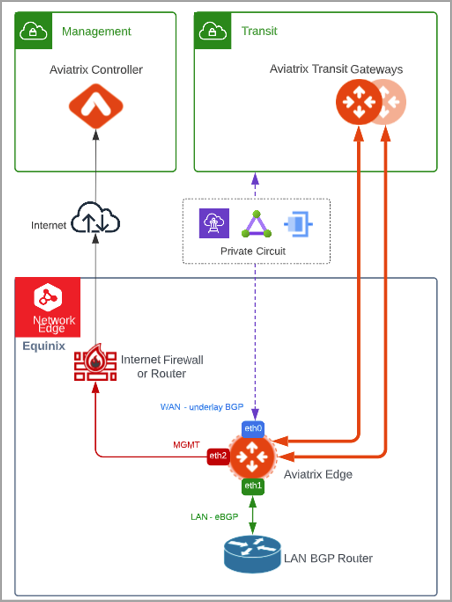Deploy an Edge Spoke Gateway on Equinix Network Edge
This document provides instructions to deploy a primary Edge Spoke Gateway on Equinix Network Edge.
For an overview of Aviatrix Edge, see About Aviatrix Hybrid Cloud Edge.
Topology
The following diagram shows an example of network connectivity for Aviatrix Edge Spoke Gateway to Transit Gateway in AWS. This topology shows Aviatrix Edge Spoke Gateway connection to an upstream WAN router which is used to terminate CSP underlay private connections.

The topology below shows Aviatrix Edge Spoke Gateway used to terminate CSP underlay private connections (which does not require upstream WAN router).

| Aviatrix Edge Spoke Gateway requires the latest versions of Aviatrix Controller 7.1 and Aviatrix Edge Image 7.1 or higher to support BGP underlay connectivity to CSP. |
Prerequisites
Before you deploy an Aviatrix Edge Spoke Gateway on the Equinix platform, ensure the prerequisite steps are complete.
Deploy the Primary Edge Spoke Gateway (Equinix)
To deploy an Edge Spoke Gateway, first you need to generate the cloud-init file in CoPilot, then deploy the Edge gateway in Equinix using the cloud-init file:
Next Steps
-
For high availability (HA) and redundancy, you can create and deploy HA Edge Spoke Gateway. See Deploy a HA Edge Spoke Gateway (Equinix).
-
For hybrid, multicloud, or LAN-side connectivity, you can attach the Edge gateway to multiple Aviatrix gateways . See Edge Gateway Attachments.
-
For remote site connectivity, you can connect the Edge gateway to remote devices. See Edge Gateway External Connection.